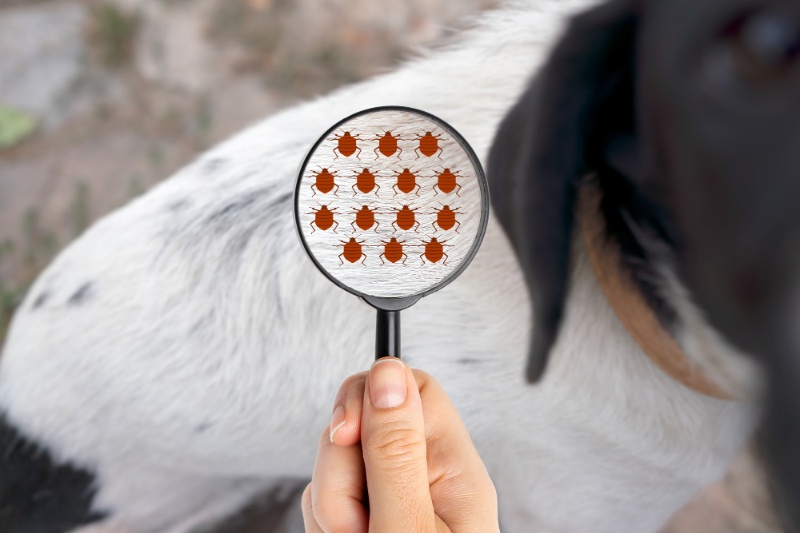Fleas – we’re all too familiar with these minuscule, troublesome insects. Not only are they a source of irritation, but they also survive by feasting on the blood of our pets and have the potential to transmit various diseases. This makes them a prevalent concern among pet owners globally. In this article, we delve into how to tell if your pet has fleas by observing their behaviour and conducting detailed inspections. Armed with knowledge about effective flea detection techniques, you’re better equipped to ensure the well-being and happiness of your cherished pets!
Understanding fleas on pets
What are fleas?
Fleas are diminutive, reddish-brown insects, typically measuring around 2-3 mm in length. They are characterised by their flattened bodies and elongated hind legs, attributes that enable them to leap impressive distances, often several hundred times their body length. The life cycle of fleas allows them to rapidly multiply under suitable conditions, posing a significant risk to pets.
The impact of fleas on pets
The advent of fleas on your beloved pet can precipitate a multitude of health issues, severely impacting their overall well-being. Incessant scratching behaviour is often a telltale sign, which can escalate to hair loss and inflamed skin, subsequently leading to potential secondary infections.
Moreover, certain dogs may develop a hypersensitive reaction known as flea allergy dermatitis (FAD), a condition triggered by the saliva of fleas. This allergic reaction is characterised by an intense itching sensation, culminating in redness or the formation of bumps across the skin.
How to tell if your pet has fleas!
Excessive scratching, biting, or licking
A common sign of a flea infestation is when pets start to exhibit unusual behaviours such as excessive scratching, biting, or licking. These actions are often the initial signs that your pet is uncomfortable and possibly suffering from the presence of fleas on their body.
Hair loss, red patches, and skin infections
Should you observe your pet experiencing hair loss in specific areas, the emergence of red patches, or signs of skin infections, these could all be indicative of a flea problem. Such symptoms should not be taken lightly, as they signify your pet’s discomfort and the potential for more serious health issues.
Spotting flea dirt
A thorough check of your pet’s coat for live fleas or their excrement, commonly referred to as “flea dirt,” is crucial. This flea dirt, appearing similar to grains of black pepper, is the digested blood from your pet and serves as a clear sign of flea activity.
Checking your pet for fleas: a step-by-step guide
Conducting a visual inspection
Initiate your inspection by examining your pet’s coat and skin meticulously. You may need to part their fur in specific areas, such as behind the ears, under the belly, or near the tail base, as these are common hiding spots for fleas.
The white towel test
Employing a white towel serves as a straightforward yet effective method to identify fleas, especially on pets with darker fur. Position your pet on the towel and proceed to give them a thorough rub down. Pay special attention to areas where fleas are most likely to be found. The white backdrop of the towel makes it easier to spot fleas or flea dirt that falls off.
When to consult a vet
Noticing excessive scratching or behavioural changes in your pet, alongside other symptoms such as hair loss and irritated skin, warrants immediate consultation with a veterinarian.
For severe infestations or scenarios where multiple pets are affected, professional assistance is strongly advised to ensure effective treatment and prevention strategies.
Fleas across different pets
Fleas on dogs
Dogs afflicted with fleas will often manifest through excessive scratching, biting, or licking at their skin. These symptoms can lead to hair loss in patches, redness, and the development of bumps on the skin. Additionally, some dogs may experience acute discomfort resulting in hot spots – severely inflamed skin areas caused by persistent flea bites.
Particularly susceptible breeds or individual dogs may suffer from intense reactions due to an allergy to flea saliva, leading to the development of Flea Allergy Dermatitis (FAD), a condition that necessitates prompt veterinary attention.
Fleas on cats
For cat owners, it’s crucial to understand that cats are often more discreet about their discomfort, making it a bit more challenging to detect fleas compared to dogs. Unlike dogs, cats might not scratch as aggressively in response to flea infestations. Instead, they might engage in excessive grooming, which, while less obvious, can be equally harmful. This over-grooming can lead to hair loss and potentially cause open wounds or sores from biting at their skin in an attempt to relieve itchiness.
Another sign to look out for in cats is the presence of small scabs around the neck area, which can indicate flea bites. Additionally, visible bite marks on their belly or inner thighs, or the discovery of tiny brown specks (flea dirt) particularly near their hind legs, are clear indicators of flea presence. Since most flea dirt tends to fall off onto surfaces where your cat spends time, it’s advisable to regularly check these areas as part of your flea detection routine.
The next steps – preventing and eradicating fleas
Maintaining cleanliness in your home and surrounding environment plays a pivotal role in the prevention and control of fleas. Regular hoovering of carpets, furniture, and pet bedding can significantly reduce the flea population and limit their ability to breed.
Moreover, the usage of flea control products should be a routine aspect of your pet care regimen. When selecting these products, prioritising those that are natural and safe for pets and humans alike, such as Flea Guard tablets from VETIQ, ensures peace of mind and reduces the risk of adverse reactions.
VETIQ Flea Guard tablets are 100% safe and suitable for cats and dogs and are the only preventative products on the market! These products need about six weeks to become fully effective at protecting your beloved pets – but once protected, your furry baby can say goodbye to nasty fleas once and for all!
In our follow-up article, What To Do If Your Pet Has Fleas!, we explore what solutions can be integrated into a comprehensive approach to flea care, emphasising the importance of prevention as the best form of protection against these pesky creatures, so stay tuned for valuable insights into keeping your pets flea-free and happy!








